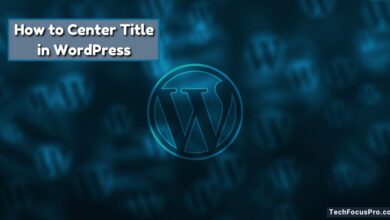From Speed to SEO: 6 Tips for Better Site Performance

Web performance significantly impacts user experience, search engine rankings, and overall online success. If your website isn’t quick to load, informative, and user-friendly, it could negatively impact visitor retention and conversions.
Your website should perform at top speed and adhere to SEO best practices to stand out. Read on to explore six tech tips designed to optimize site performance and improve your standing in search engine results. Look no further!
Focus on Page Load Speed
The first step towards improved site performance is to check if it loads quickly. Most consumers expect a web page to load in just a few seconds.
Slow-loading sites lead to increased bounce rates and diminish visitor engagement. Leverage Google PageSpeed Insights or similar tools to assess your website’s speed and identify areas for improvement.
Compressing images, minifying CSS and JavaScript, and utilizing browser caching can reduce load times.
For optimal results, conduct regular speed tests to track your progress. Fast performance attracts users and benefits your SEO rankings simultaneously.
Focus on page load speed, and you’ll know you’re setting the stage for an excellent user experience and effective SEO practices.
Read More:- How SEO and Web Design Work Together for Success?
Collaborate with an SEO Agency

An effective way to elevate your website performance is by collaborating with an SEO agency. These experts bring invaluable experience in both technical and content-related strategies designed to enhance your site.
They can assist in performing thorough audits to identify areas for improvement, optimize content for search engines, and refine user experience elements.
A professional agency will stay up to date with evolving algorithms, ensuring your website maintains strong visibility on search engine results pages.
They can help develop a solid SEO plan that addresses your specific objectives at an affordable price. Leverage their expertise, and you maximize the potential of your website.
Investing in professional collaboration can lead to better site performance and favorable search rankings.
Implement Caching Solutions
Caching stores copies of files or website data for quicker access. Repeat visitors can access your site quickly without reloading all elements.
Combine server-side caching plugins, such as W3 Total Cache or WP Super Cache for WordPress, to manage your cache efficiently. Browser caching enables user browsers to store specific files, thereby speeding up subsequent visits.
A Content Delivery Network (CDN) can push cached content to servers located closer to the user, thereby decreasing load times. Without caching, your server has to work tirelessly to serve every visitor.
Embrace effective caching solutions to improve user experience and fulfill your website’s performance objectives.
Minimize HTTP Requests

Each element on a webpage generates an HTTP request, from images to scripts and stylesheets. Too many requests can lower page load speed.
To minimize these requests, strive to reduce the number of on-page elements, combine CSS files, and utilize techniques such as CSS sprites for images. A streamlined approach simplifies your code, resulting in fewer requests to the server.
Consider lazy loading for images and videos, which allows these elements to load only when users scroll near them. This method can enhance perceived performance while maintaining visual quality.
Using Google’s PageSpeed Insights gives insights into your HTTP requests, helping you strategically reduce them. Minimizing HTTP requests optimizes your site’s performance.
Leverage Responsive Design
Responsive design guarantees your website looks and functions seamlessly across all devices. A mobile-friendly design enhances SEO rankings, as search engines prioritize mobile-optimized sites.
Your images should adapt to screen size, and your layout should adjust accordingly. Tools can help you incorporate responsive design principles efficiently.
Test your site using the Mobile-Friendly Test tool to identify and remedy issues promptly. Failing to adopt responsive design could result in losing valuable traffic, as users abandon sites that aren’t mobile-friendly.
An enhanced mobile experience can lead to improved engagement metrics, positively impacting your search engine performance and driving desirable growth.
Monitor and Analyze Performance Metrics

Don’t forget to closely monitor performance metrics. Google Analytics and Google Search Console gather valuable data about site traffic, bounce rates, and user behavior.
Analyzing these metrics enables you to identify trends and areas that require improvement. Engagement metrics such as average session duration and pages per session provide insight into user interaction with your site.
Regularly monitor these metrics to tailor your strategies for optimal performance. Recognize that performance optimization is an ongoing process, necessitating continuous analysis and adjustment.
Stay proactive and engaged with your data, and you can maintain a high-performing website that both attracts and retains visitors.
Improving the performance of your website is a multifaceted endeavor that can enhance both user experience and search engine visibility.
Prioritizing speed, implementing optimization techniques, and aligning with effective SEO practices will lead to a better user experience and higher search engine rankings. By strategically applying these tech tips, you position your site for long-term success.
Read More:- Advantages of White Label SEO Services in Digital Marketing
FAQs
Why is website speed important for performance and SEO?
Website speed has a direct impact on user experience and bounce rates. A fast-loading site keeps visitors engaged and is favored by search engines, which can result in improved rankings.
How can I test and improve my site’s load speed?
You can use tools like Google PageSpeed Insights or GTmetrix to analyze speed. Improvements may include compressing images, enabling caching, and minifying CSS/JavaScript files.
What role does caching play in site performance?
Caching stores parts of your website temporarily, allowing returning visitors to load pages faster. It reduces server load and significantly improves speed and user experience.
Why should I work with an SEO agency?
An SEO agency brings technical expertise and up-to-date strategies that help optimize your site for search engines and users. They can perform audits, improve speed, and help maintain ranking over time.
How do HTTP requests affect page speed?
Each image, script, or style on a page creates an HTTP request. The more requests, the slower the site. Minimizing and combining files reduces load time.
What is responsive design, and why is it important?
Responsive design ensures your site adjusts to different screen sizes. A mobile-friendly site improves user experience and ranks better in mobile search results.
How often should I monitor my website’s performance metrics?
Regular monitoring, conducted weekly or monthly, is ideal. Tools like Google Analytics and Search Console help track key metrics and guide ongoing improvements.
Conclusion
Enhancing your website’s performance is not a one-time task—it’s a continuous journey that blends speed, SEO, and user experience into a single strategy. From reducing page load times and HTTP requests to embracing responsive design and leveraging caching, each of the six tech tips plays a crucial role in optimizing your site’s performance. Collaborating with an SEO agency and consistently monitoring your performance metrics ensures you stay ahead of algorithm changes and user expectations. Ultimately, by implementing these techniques, you not only create a faster and more reliable website but also enhance your visibility in search engine rankings, resulting in increased traffic, engagement, and long-term online success.






